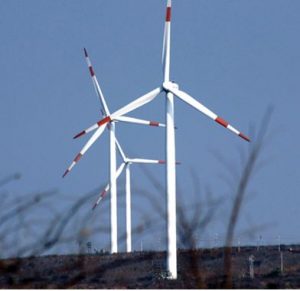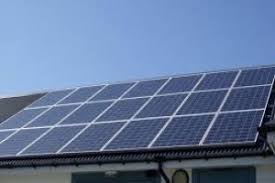 By Dr P. K. Jena* in Bhubaneswar, May 5, 2022: Limited reserves of fossil fuels and their soaring price along with environment polluting nature, in recent decades all over the world efforts are being made to use increasing amount of renewable energy resources. There is unlimited potential of clean energy resources from sun, wind, biomass and small hydro power, in the world.
By Dr P. K. Jena* in Bhubaneswar, May 5, 2022: Limited reserves of fossil fuels and their soaring price along with environment polluting nature, in recent decades all over the world efforts are being made to use increasing amount of renewable energy resources. There is unlimited potential of clean energy resources from sun, wind, biomass and small hydro power, in the world.
It has been found that, carbon dioxide emission in earth’s atmosphere can be reduced by 3.3 Million Tonnes (MT) per year by adding 1 Gega Watt (GW) energy of renewable origin in place of fossil fuel and thus appreciably minimizing the global warming problems. In view of this, efforts are being made to harness energy from wind in a much bigger way compared to other renewable energy sources because of its certain advantages over other forms of renewable energy. Annual growth of wind energy all over the world is almost 25 pct.
India is fast developing through utilization of its resources by applying modern science and technology. In this process, the electricity demand in the country is expected to rise by 7.4% annually for the next two and half decades. In view of limited supply of fossil fuels and their harmful effect on environment, it has been necessary to harness energy from various clean renewable sources including the wind power.
The wind energy programme started in a systematic way in India by the end of 6th Five Year Plan (1983-1984) and during these years an appreciable amount of wind energy is being harnessed for various purposes in different parts of the country. The main objective of the programme should be to commercialize wind energy production in a big way, support research and development, provide more incentives to set up wind energy projects and to create awareness among the people. The total installed wind power capacity in India had reached 17.9 GW in August 2012.
The total capacity added during the financial year 2012-2013 was around 1,700 MW. Presently, India has an installed total power generation capacity of a little over 207.8 GW, of which renewable account for about 25 GW and wind is the major one of this installed capacity. In 2012 National Electricity Plan, the Central Electricity Authority had projected the need for 350-360 GW of total generation capacity by the year 2022.
 India has got long coastal line over 7500 Km with good potentiality of wind energy, but harnessing the wind resource has come up mostly in Gujarat and Tamilnadu. It is reported that, in India 119.5 billion units (BU) of electricity have been added to the total electricity supply from wind energy. In this process, the country has saved 89.72 million tonnes (MT) of coal and decreased the CO2 emission by 118.29 MT. This indicates the environmental and economic validity of harnessing wind power in India.
India has got long coastal line over 7500 Km with good potentiality of wind energy, but harnessing the wind resource has come up mostly in Gujarat and Tamilnadu. It is reported that, in India 119.5 billion units (BU) of electricity have been added to the total electricity supply from wind energy. In this process, the country has saved 89.72 million tonnes (MT) of coal and decreased the CO2 emission by 118.29 MT. This indicates the environmental and economic validity of harnessing wind power in India.
Therefore, it is essential to initiate more projects to extract electrical energy from wind in various possible ways both offshore and onshore areas of the country. The installed wind capacity of major states of India is given in as per the Indian wind atlas of 2010 prepared by the Centre for Wind Energy Technology (C-WET) and the potential has been calculated based on availability of 2% of total land for setting up wind energy turbines at a 50 meters height level. The major installed wind capacity of India is around 28083 MW.
If the wind energy potential at a height of 50M is harnessed fully then it can provide only 8% of the electricity demand of the country in the year 2022 and 5% in 2032. However, at 80 metres height the projected wind potential for the same area of land used (2%) will be in the order of 1,02,788 MW whereas at 50m height, it is 49,130 MW. More than 95% of India’s wind energy development is concentrated mostly in five states namely Gujarat, Tamil Nadu, Karnataka, Maharashtra, and Andhra Pradesh.
It is encouraging that, India is manufacturing wind turbine and supplying to both inside user and outside user countries like Thailand, Turkey, Netherlands, Srilanka, UK etc. In this programme, nearly 18 manufactures are engaged and they have a consolidated annual production capacity of over 10,000 MW. It is also reported that, some of the International Companies with subsidiaries in India are sourcing over 80% of the components which are manufactured in India.
By middle of 2014, India had installed 31,831 MW renewable energy capacities, out of which wind energy accounted 21,268 MW. Wind energy is followed by the small hydro power of 3803 MW and this is followed by solar power of 2647 MW. From 2002 to 2011, the average growth of wind energy in India was 26.87%. By March 2014, the installed capacity of wind energy in India went up to 21,136 MW.
The manufacturers association of wind turbine in India has played a very significant role in development and execution of various wind energy programmes, in addition to the incentives given by the government of India. The Government of India as a part of its obligation to the United Nation Climate Convention (UNCC) has formed a national action plan on climate change (NAPCC).
 As per the estimation made by NAPCC, the renewable energy purchase target of 5% of the total grid purchase was prescribed for 2009-2010. It was planned that by 2020, the renewable energy source contribution should go up to 15%. In this programme, the wind energy should play a major role.
As per the estimation made by NAPCC, the renewable energy purchase target of 5% of the total grid purchase was prescribed for 2009-2010. It was planned that by 2020, the renewable energy source contribution should go up to 15%. In this programme, the wind energy should play a major role.
In order to popularize the programme for harnessing wind energy, the Government of India has set up a number of demonstration projects in the states like Tamilnadu, Gujarat, Madhya Pradesh and Karnatak with the support of Danish International Development Agency (DANIDA). Such demonstration projects should came up in other states of the country in order to expedite the programmes to harness wind energy. It may be mentioned here that India is much behind many other countries in harnessing wind power.
Wind energy projects need a sizeable capital investment, but the recurring cost is very low. The capital cost for 1 MW wind energy project in India is about 60 Million Indian Rupees. In view of high investment cost, it is reported that the Government of India has been offering inducement to individual investors for harnessing wind energy. The largest wind farm of India named as ‘Yermala’ wind farm has been established in Maharashtra. In addition to this, there are a number of other major wind farms like “Abdasa” wind farm in Gujarat, ‘Muppandal wind farm’ in Tamilnad, ‘Andhra lake wind farm’ in Andhra Pradesh and ‘Khandke wind farm’ in Maharastra.
It is reported that, the Government of China by offering various incentives has been able to increase the installed capacity of wind energy more than any other country in the world. India Government should enhance the wind energy harnessing capacity by giving similar incentives. More importance should be given to set up offshore and onshore wind energy harnessing plants with high capacity wind turbines developing wind energy technology and enhancing regulatory and tariff regime to bring into National Power System.
In this process India can save a lot of foreign exchange for importing fossil fuels while effecting rapid socio economic development under a clean and healthy environment.
*Former Director General, Council of Scientific & Industrial Research, India



Leave a Reply
Be the First to Comment!